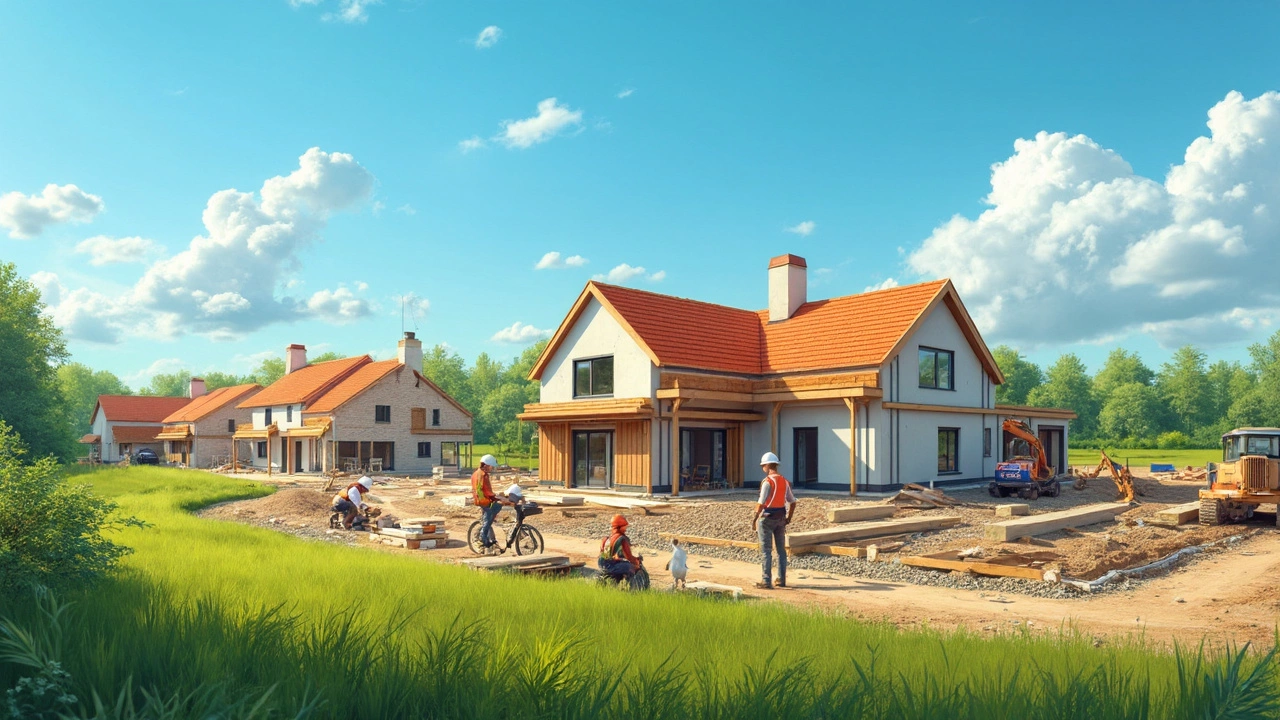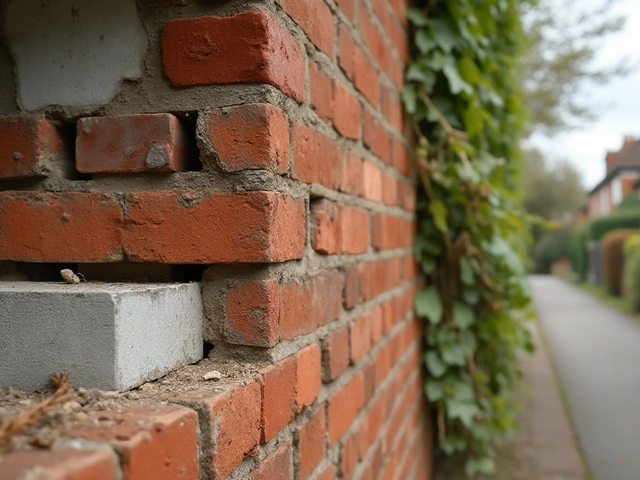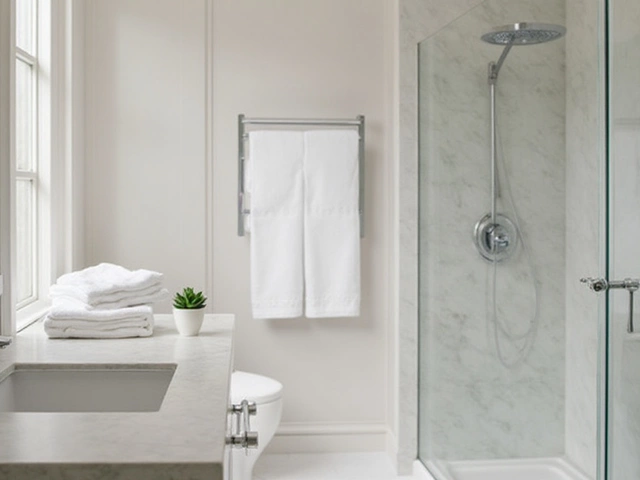So, you've just moved into your snazzy new build, only to spot a few sneaky cracks creeping up your walls. No one wants that, right? Cracks aren't just eyesores; they can hint at bigger problems. But good news—most of these can be prevented before they become an issue. Let's dig into what causes these pesky problems and how you can nip them in the bud.
Understanding the basics is the first step. It's not uncommon for fresh builds to settle, but sometimes certain factors kick things up a notch. Soil movement, that's a biggie. If your house is sitting on unstable ground, you're gonna see effects. Moisture levels play a major role too. Too much water can make the soil expand, and too little can make it shrink—neither is great for your foundation.
Choosing the right foundation can seem boring, but trust me, it's crucial. Depending on the type of soil where you're building, different foundations might work better. Sure, it's tempting to opt for the cheaper option, but investing in the best choice now can save you a lot of headaches down the line.
- Understanding the Causes
- Foundation Matters
- Right Materials for the Job
- Managing Moisture Levels
- Temperature's Impact
- Routine Maintenance Tips
Understanding the Causes
Ever notice how some homes seem to age before their time, with unsightly cracks appearing in all the wrong places? Knowing why cracks are happening in your new builds is like solving a mystery. The key suspects are usually lurking in the ground and weather patterns, and sometimes it’s about the choice of materials.
First off, let's talk soil movement. This is a big deal because the stability of your home literally starts from the ground up. Certain types of soil, especially clay, like to move around with changing moisture levels, expanding and contracting easily. If the soil swells, it pushes up against your foundation, and when it shrinks, it leaves gaps—both scenarios aren’t great for keeping your walls crack-free.
Water is another usual suspect. Too much or too little can be a real headache. Say it rains heavily, and your property isn’t equipped with proper drainage. The excess water can saturate the soil, causing it to swell and become unstable. The reverse is true during a drought when dry soil contracts.
Now, let’s not forget the impact of temperature changes. Hot summers and chilly winters can seriously mess with your home. Materials expand with heat and contract with cold, leading to potential cracks. Using the right mix of insulation can be a lifesaver here.
| Cause | Impact |
|---|---|
| Soil Movement | Foundation stress |
| Water Levels | Soil expansion/shrinkage |
| Temperature | Material stress |
Understanding these factors can put you in a better position to stave off those irritating cracks. Addressing these issues from the get-go helps maintain the integrity and appearance of your new build, ensuring it stays looking like new for years to come.
Foundation Matters
Your home's foundation is kinda like Max, my trusty dog—it's gotta be solid, dependable, and built to last. If the foundation's shaky, everything can go downhill fast. So, what's the big deal with getting this right? Well, the right foundation can prevent those annoying cracks that pop up in new builds.
Let's break it down. The kind of soil your house is sitting on is a huge factor. Clay, sand, and loamy soils react differently to water. Clay expands when wet and shrinks when dry, while sandy soil might let water drain too fast. Knowing this helps when picking a foundation type.
There are three typical types of foundations you might consider:
- Slab Foundations: They're flat and usually poured directly onto the ground. Great for areas where the soil remains pretty stable.
- Crawl Space Foundations: These keep your house a bit elevated, allowing for some air circulation under your home. Perfect if you need extra moisture control.
- Basement Foundations: Ideal if you want more living space or need serious protection against soil movement. Though pricier, they add tons of extra space.
But remember, it's not just about the type—how it's built matters too. Water-proofing, proper drainage, and reinforcement are steps you shouldn't skip. Without those, even the most expensive foundation can crumble over time.
If you're already knee-deep in planning or construction, think about hiring a structural engineer. These folks can point out soil issues before they become a real pain, and give you the lowdown on the best materials and techniques for cracks prevention and durability.
Right Materials for the Job
Picking the right materials for your new build might seem like just another checkbox on the list, but it's actually a game-changer, especially when you're aiming to prevent cracks. Let's break down why some materials make the cut, while others leave you with a problematic fix.
First up, concrete. It's the backbone of any stable structure, but here's the kicker: not all concrete is created equal. High-quality concrete mixed properly can withstand a lot of pressure. Make sure the mix ratio is spot on—usually, a mix of cement, sand, aggregate, and water. A little secret? Add some fibers. They help reinforce the mix, reducing crack potential.
When it comes to construction, the soil plays a major role. You'll want to consider materials that work well with the type of soil on your property. For example, if you're on clayey ground, opting for materials with good moisture resistance is crucial.
Steel is another rockstar here. Reinforcing your structure with steel bars—commonly known as rebar—provides extra strength. It works well with concrete, making the entire setup more flexible and less likely to crack when the ground shifts slightly.
| Material | Benefits |
|---|---|
| High-quality concrete | Durable, pressure-resistant |
| Steel reinforcement | Adds flexibility, prevents cracks |
| Fibers in concrete mix | Extra reinforcement |
Don't forget about the moisture barriers. These are especially important in areas with a lot of rain. Utilizing moisture barriers in the foundation keeps the concrete from absorbing too much water, preventing it from cracking as it dries unevenly.
Last but not least is choosing the right mix of wood for framing. Always go for kiln-dried wood. It's less likely to warp or bend, which means the overall frame stays firm, reducing the chance of developing structural cracks as the house settles.

Managing Moisture Levels
Let's talk about one of the unsung heroes of a crack-free home—moisture management. You might think your new build is solid, but ignoring moisture levels is like leaving the door open for trouble. Too much or too little moisture can cause havoc by expanding or shrinking the soil beneath your house. Sounds messy, right?
The first step to managing moisture is keeping an eye on your landscape. Make sure you have a proper drainage system in place. This means grading your yard so that water flows away from the foundation instead of pooling around it like an unwanted swimming pool. An efficient gutter and downspout system isn't just a nice-to-have; it's a must. Ensure they're clear at all times so rainwater is swiftly directed away from your building.
Another smart move is to maintain a consistent moisture level around your property. Using soaker hoses during dry spells can help prevent the soil from contracting too much. Remember, you want just enough water to keep things stable, not soggy. On the flip side, during rainy seasons, it's a good idea to check for any water accumulation spots that need addressing.
Here's a quick roundup on what you can do:
- Check if water drains effectively around your home.
- Ensure gutters and downspouts are clear of debris. No one likes a clogged system!
- Use soaker hoses in dry periods to maintain steady moisture levels.
- Watch out for any spots in your yard that seem to collect water excessively.
Also worth mentioning, using moisture meters can provide insights into soil conditions. These nifty tools can alert you when it's time to add or draw back water, keeping that balance just right.
By keeping a close eye on these pesky moisture levels, you'll be doing yourself—and your house—a big favor. It’s all about keeping that balance to prevent those cracks from elbowing their way into your home sweet home.
Temperature's Impact
Temperature can mess with your new home's mojo more than you might think. If you've ever lived through a sweltering summer or a nippy winter, you know how much the weather can affect everything. Your new build isn't immune to these shifts, and they can actually cause cracks to appear.
Simply put, building materials expand and contract with temperature changes. When it's hot, materials like concrete and wood expand. When it gets cold, they contract. This constant push and pull can put a lot of strain on your house's structure, potentially leading to those pesky cracks.
So what can you do to keep your house steady and crack-free? Here are some tips:
- Use flexible materials: Some materials handle temperature changes better than others. Talk to your builder about using more resilient materials that can take the heat (or cold).
- Add insulation: Good insulation helps keep the temperature inside stable, which can minimize stress on your home's structure.
- Try temperature thresholds: Be aware of the temperature ranges in your area and make sure your building materials can handle those extremes.
According to data, the average home requires about 12 inches of insulation. This can reduce your energy bills and help protect your home from temperature-induced cracks. Keeping these tips in mind can help you prevent unwanted surprises as the seasons change.
Routine Maintenance Tips
Okay, you've got your new build looking spiffy, but keeping it crack-free means staying on top of routine care. Think of it like keeping a plant alive—you can't just water it once and forget about it. Here's how you can keep those cracks at bay:
- Check for leaks regularly: Water is a sneaky culprit that can wreak havoc on your foundation. Peek under sinks, around windows, and check the roof. Fix any small leaks before they turn into a big headache.
- Keep an eye on trees and vegetation: Those towering trees might look great, but their roots can mess with your foundation over time. Make sure they're planted at a safe distance, and keep them trimmed.
- Gutter and drainage maintenance: Gutters might not be glamorous, but they're essential. Clean them out regularly to ensure proper drainage. If water pools around your home, it can lead to soil shifting and, you guessed it, cracks.
- Inspect walls and floors: Give your walls and floors a good once-over now and then. Look for tiny cracks and address them ASAP. A little patchwork now can save a larger repair job later.
- Control humidity levels: Too much humidity can be bad news. Get a dehumidifier if needed, to prevent excess moisture from affecting your building materials. It helps maintain the structural integrity of your house.
Consistency here is key. Keeping up with these tasks might seem like a chore, but they do wonders in preventing those unsightly cracks. Plus, taking care of your house foundation not only maintains its good looks but also its value. And who doesn't want their house to last?





